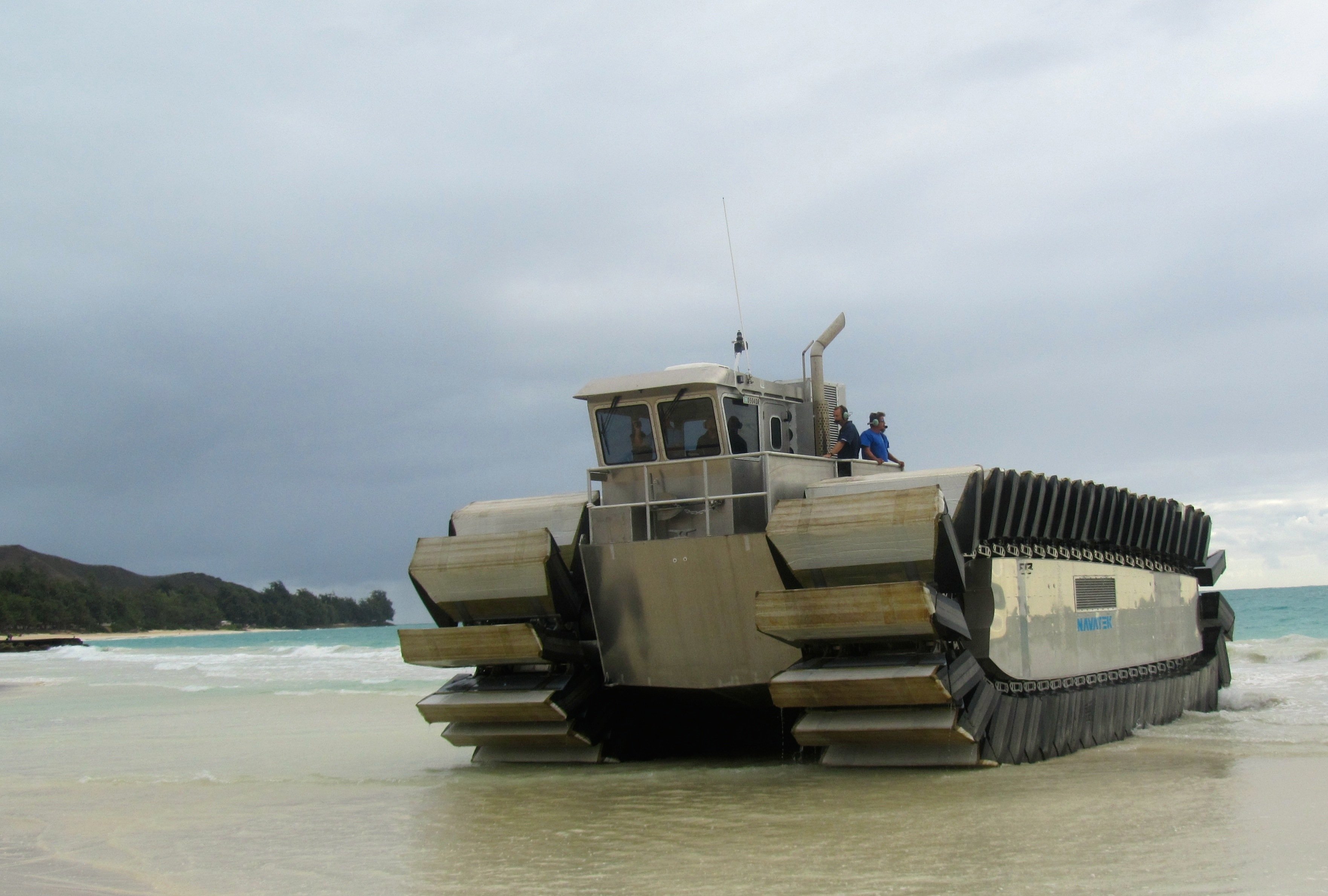
MARINE CORPS TRAINING AREA BELLOWS, HAWAII — The Marine Corps recently tested a prototype for heavy-duty amphibious landing craft that could one-day transport up to three M1A1 Abrams from ship to shore at 20 knots.
The new Ultra Heavy-Lift Amphibious Connector (UHAC) — currently being tested by Marine Corps Warfighting Laboratory as part of the ongoing Rim of the Pacific 2014 exercises — a revolutionary new amphibious transport design using foam treads for movement on both land and at sea.
During a July 11 press demonstration, the UHAC paddled to shore using its foam treads, then climbed out of the surf and traversed a small berm like a tracked vehicle. Brig. Gen. Kevin Killea, MCWL commander explained at a press conference shortly afterward, “[UHAC] is a collaborative effort between the U.S. and the nation of Singapore,” Killea explained, “to look at future connector capabilities ship to shore. The demonstration is mostly to look at how we can get a lot of equipment and get it from the ship to the shore quickly, but also get it over difficult terrain.”
MCWL is conducting an Advanced Warfighting Experiment within RIMPAC designed to test a host of future technologies — including UHAC — under field conditions.
In addition to UHAC, MCWL is testing communications, energy, medicine and command and control equipment prototypes. The experiment is also testing doctrinal concepts, including the viability of a Company Landing Team (CLT).
UHAC is collaboration between the Office of Naval Research and the Singapore Ministry of Defense Science and Technology department. Known as Connector Next, the program is investigating UHAC as a potential replacement for either the Landing Craft Utility (LCU) or possibly the Landing Craft Air Cushion (LCAC).
The current UHAC concept demonstrator is a 4/10 scale developmental prototype 42 feet long, 26 feet wide, and18 feet tall. The vehicle weighs 38 tons and is capable of approximately 4-5 knots. The hull is made of aluminum, with a small pilothouse mounted on the bow.
A full-sized UHAC is projected to be 84 feet long and up to 34 feet high. It will also be capable of doing 20 knots at sea with a range of 200 miles. It will be capable of carrying up to three M1A1 Abrams tanks, or 190 tons of cargo.
Killea was not particularly concerned about the UHAC’s speed at sea. “It would be potentially faster than an LCU but not an LCAC…an LCAC can do 30 knots, about, depending on the seas. This is really about size and weight, what it can carry, to replace the LCU or LCAC in the future.”
UHAC is capable of not only hitting the beach, but maneuvering inland across difficult terrain. Key to the UHAC are the non-absorbent foam treads that act as paddles in the water and tracks on land. The captive air cells provide buoyancy and spread the weight of the vehicle out to one pound per square foot of foam, enabling it to cross difficult coastal terrain such as tidal flats and swamp. Impressions on the ground left by the 38-ton UHAC concept demonstrator were noticeably light.
The UHAC would be an operational maneuver from the sea asset, transporting slower platforms. Killea said that the UHAC would be faster than the amphibious 1960s era AAVs and could even be used to carry AAVs and bring them to closer to shore.
The current UHAC demonstrator is not designed for survivability but rather validating the paddle track concept. Future developments of the UHAC program will begin focusing on protection from hostile fire. Killea noted that a more survivable version would likely be faster and have a lower profile.
The general anticipated the Marine Corps would use the UHAC as a connector from ship to a secured beachhead. Like the current LCU, it would not be designed to go against an “aggressed shore.”





